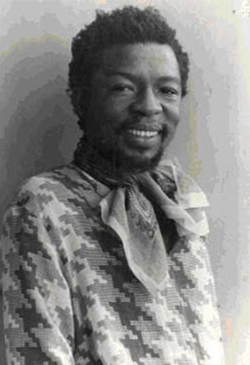Charles Sekano
South Africa

Charles Sekano was born in 1943 in Johannesburg’s Sophia Town, in South Africa.
His youth was cruelly overshadowed by the consequences of the Apartheid. After he was denied permission to study at the University of Swaziland, he left his home and family at the age of 21. He then traveled through North, West and Central Africa before becoming stranded three years later in Kenya.
In Nairobi during the the 1960s, amid the very real isolation of exile, Sekano forged himself into both a self-taught artist and musician, working as a Jazz pianist in the multiracial bars and nightclubs of this rough edged African metropolis.
His artistic expression was and is informed by the sense of loss experienced by the severing of family bonds. Women, for Sekano – those that he immortalises in his works – became his world and his artistic language.
In Nairobi, Sekano lived life in the tradition of a romantic bohemian artist and musician, developing his own version of the ‘Three Ps’ – Painting, Poetry and Piano. And – like Degas and Toulouse Lautrec before him – living amongst his mostly female subjects. During his years of exile, Sekano waged his own passionate war against the Apartheid regime with paintbrush and crayon, colour itself beginning to symbolise freedom for him.
Whilst influences of Picasso and Braque’s Cubism and Toulouse-Lautrec’s and Henri Rousseau’s poster art are clear in his work, Sekano has always rooted himself in the realities of cosmopolitan, urban Africa. The nightclubs and bars of Kenya with their beautiful female clientele from diverse cultures across Africa were his subject matter and remain his inspiration. Sekano is never moralistic, always humanistic – his works celebrate and preserve moments.
In the 1960s ‘The Winds of Change’ blew through Africa, though South Africa had to wait for another 30 years for liberation. It was only in 1997, now over 50, that Charles Sekano returned to South Africa again – now with his Kenyan wife and two grown children.
His re-entry into a newly liberated South Africa came with mixed feelings, leaving behind a country he had grown to love and re-joining a society that had largely forgotten him – the fate of many a returning exile.
Charles Sekano has exhibited widely in Kenya, Holland, Germany, Japan, the US, UK and South Africa. His works are in private collections across the world and in various museums, including the Völkerkunde Museum in Frankfurt, Germany and the Peabody Essex Museum in Massachusetts, USA.

Untitled | Acrylic on Paper |75cm x 50cm
- ca. 1995 -
Code: SEKA07

Untitled | Pastel on Paper |51cm x 76cm
- ca. 1995 -
Code: SEKA5

Untitled | Pastel on Paper |51cm x 76cm
- ca. 1995 -
Code: SEKA2

Untitled | Pastel on Paper |51cm x 76cm
- ca. 1995 -
Code: SEKA3

Untitled | Pastel on Paper |51cm x 76cm
- ca. 1995 -
Code: SEKA6

Untitled | Pastel on Paper |51cm x 76cm
- ca. 1995 -
Code: SEKA4
